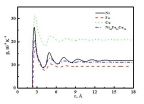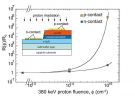Despite advances in lymphoma treatments, improving the prognosis for patients with relapsed and treatment-resistant disease remains a challenge. The early success of several precision therapies associated with fewer side effects than conventional approaches offers new hope for conquering aggressive disease. For lymphoma patients who relapse or do not respond to initial therapy, stem cell transplantation also presents a potentially curative option; however, this procedure is not always successful. Two studies presented today detail methods to improve outcomes in patients with relapsed or hard-to-treat lymphoma, including adding a targeted antibody to standard treatment to prevent relapse after transplant, and an approach to making stem cell transplantation the standard of care for patients with HIV-associated lymphoma.
In three other studies, researchers will describe new advances in the treatment of myeloma. These reports are examples of new precision treatments, including a proteasome inhibitor and two anti-CD28 antibodies that demonstrate encouraging results when combined with standard care for patients with relapsed and treatment-resistant disease.
"While eradicating aggressive lymphoma and multiple myeloma remains a major hurdle, the emergence of several promising strategies makes this an exciting time for physician-scientists in this field," said Brad Kahl, MD, moderator of the press briefing and Associate Professor of Medicine at the University of Wisconsin School of Medicine and Public Health in Madison. "By combining therapies and studying outcomes in vulnerable subsets of patients, we are learning more about how we can best help those who have not responded to any other treatment."
This press briefing will take place at 8 a.m. PST on Saturday, December 6, in rooms 236-238 of Moscone South, East Mezzanine.
Brentuximab Vedotin Prolongs Post-Transplant Survival in Hard-to-Treat Lymphoma Patients in Phase III Study
The AETHERA Trial: Results of a Randomized, Double-Blind, Placebo-Controlled Phase 3 Study of Brentuximab Vedotin in the Treatment of Patients at Risk of Progression Following Autologous Stem Cell Transplant for Hodgkin Lymphoma Study [673]
Roughly half of patients with relapsed and hard-to-treat Hodgkin lymphoma respond to a combination of high-dose therapy and autologous stem cell transplant, a procedure in which healthy cells are taken from the patient's own blood or bone marrow to effectively "replace" damaged cells. Unfortunately, many patients still experience recurrence of disease after undergoing this intense procedure.
This Phase III, randomized, multi-center study compared brentuximab vedotin (BV), an antibody targeting the CD30 protein on Hodgkin lymphoma cells, with placebo in 327 patients at risk of post-transplant disease progression. All trial participants had either achieved remission or had stable, non-progressing disease at time of transplant. Between 30 and 45 days after transplant, patients were randomized to receive either BV or placebo for up to one year. After a median of two years of follow up, researchers observed that patients receiving BV had a 20 percent improvement without disease progression compared to patients receiving placebo (progression-free survival rate of 65% vs. 45%) The safety profile was generally consistent with existing prescribing information. The most common events associated with BV included peripheral sensory neuropathy, upper respiratory tract infection, and neutropenia. "This is the first study in lymphoma to demonstrate that the addition of a maintenance drug after transplant can markedly improve patient outcomes," said lead study author Craig Moskowitz, MD, of Memorial Sloan Kettering Cancer Center in New York. "Given these extremely positive results, we predict that brentuximab vedotin will soon become the standard of care for Hodgkin lymphoma patients who undergo an autologous stem cell transplant."
Dr. Moskowitz will present this study during an oral presentation at 4:30 p.m. PST on Monday, December 8, in rooms 3001-3003-3014-3016 of Moscone West. Stem Cell Transplantation Safe for Patients with HIV-Associated Lymphoma
Autologous Hematopoietic Stem Cell Transplantation (AHCT) in Patients with Chemotherapy-Sensitive, Relapsed/Refractory (CSRR) Human Immunodeficiency Virus (HIV)-Associated Lymphoma (HAL): Results from the Blood and Marrow Transplant Clinical Trials Network (BMT CTN 0803)/AIDS Malignancy Consortium (AMC-071) Trial [674]
Historically, prognoses have been poor for patients diagnosed with HIV-associated lymphoma (HAL); however, highly active antiretroviral therapy has increased these patients' ability to tolerate standard of care and has led to significantly improved outcomes. Within the last decade, HAL patients have received comparable therapies to those offered to other lymphoma patients. However, because HAL patients are immunocompromised, they have been considered to be ineligible for stem cell transplantation, regarded as the standard of care for relapsed or treatment-resistant disease. As a result, HAL patients remain at a significant treatment disadvantage. To examine whether transplant could be a safe and effective approach for HAL patients, researchers from the National Cancer Institute Bone Marrow Transplant Clinical Trials Network working in collaboration with the AIDS Malignancy Consortium, conducted a large, multi-center study among 40 patients with controlled HIV infection receiving autologous stem cell transplants with a high-dose preparative regimen. Patients had persistent or recurrent Hodgkin or aggressive non-Hodgkin lymphoma. At 100 days post-transplant, 36 patients (92.3%) had achieved complete response, one (2.6%) reached partial remission, and two (5.1%) had relapsed. One patient had died. Within a year after transplant, 17 patients (42.5%) developed a total of 42 unique infections. Nine of 17 patients developed severe infection. After a median two-year follow-up, the one-year survival among the transplanted patients was 86.6 percent. The cumulative incidence of transplant-related mortality was 5.2 percent.
"These impressive survival data demonstrate that autologous stem cell transplants can be highly effective, tolerable, and not overly toxic for patients with HIV-associated lymphoma," said lead study author Joe Alvarnas, MD, of City of Hope National Medical Center in Duarte, CA. "Ultimately, our results provide a persuasive argument that HIV or AIDS status should not be a barrier to autologous stem cell transplant for patients who meet standard eligibility criteria."
Dr. Alvarnas will present this study during an oral presentation at 4:30 p.m. PST on Monday, December 8, in rooms 3001-3003-3014-3016 of Moscone West.
Carfilzomib Represents Potent, Effective Addition to Standard Multiple Myeloma Therapy in Phase III Study
Carfilzomib, Lenalidomide, and Dexamethasone vs. Lenalidomide and Dexamethasone in Patients (Pts) with Relapsed Multiple Myeloma: Interim Results from ASPIRE, a Randomized, Open-Label, Multicenter Phase III Study [79]
The recently approved targeted treatment carfilzomib has been shown to help slow or halt the spread of cancer by targeting the mechanisms that control excess proteins on which multiple myeloma cells thrive for continued growth. Carfilzomib adds to an increasing number of precision approaches that are shifting the treatment paradigm away from chemotherapy. In fact, the current global standard of care for patients with relapsed or treatment-resistant multiple myeloma is a combination of a drug called lenalidomide that specifically targets the immune system and the steroid dexamethasone.
In order to evaluate whether carfilzomib combined with standard therapy might improve treatment responses in patients with relapsed or treatment-resistant multiple myeloma, researchers enrolled 792 patients from 20 countries in a Phase III clinical trial, randomizing them to receive the standard combination of lenalidomide and dexamethasone (Rd) or the combination along with carfilzomib (KRd). Upon interim analysis, the group treated with KRd demonstrated a longer duration of response without disease progression (26.3 months) compared with the Rd-treated group (17.6 months). The difference in overall response rates in the two treatment groups was also significant, at 87.4 percent in the KRd group compared to 66.9 percent in the Rd group. Importantly, despite the addition of a drug to the regimen, no dramatic increase in toxicity was observed in the KRd group. In addition, patients in the KRd group consistently reported higher quality of life scores than those receiving Rd.
"By adding carfilzomib to the gold standard in multiple myeloma therapy, we are observing an unprecedented duration of remission without additional toxicity, a promising outcome in relapsed and heavily pre-treated patients," said lead study author A. Keith Stewart, MD, of Mayo Clinic Arizona in Scottsdale. "We hope that the results of this trial will lead to approval of this treatment combination in patients with relapsed multiple myeloma worldwide."
Dr. Stewart will present this study during an oral presentation at 12 noon on Sunday, December 7, in rooms 2001-2003-2014-2016 of Moscone West.
Daratumumab Plus Standard Treatment Improves Outcomes in Relapsed, Hard-to-Treat Multiple Myeloma in Phase I Study
An Open-Label, Multicenter, Phase 1b Study of Daratumumab in Combination with Backbone Regimens in Patients with Multiple Myeloma [176]
A new class of drugs called anti-CD38 antibodies target multiple myeloma cells by binding to an antigen (CD38) expressed on the myeloma cell and then signaling the patient's immune cells to attack myeloma cells. Daratumumab, one of three anti-CD38 antibodies under investigation for multiple myeloma, has been reported in early trials to be effective and relatively safe as a single agent in patients with relapsed or treatment-resistant disease. Given these positive results, researchers hypothesized that they could potentially improve response rates for these patients by adding daratumumab to already-proven treatment regimens.
To study the safety, tolerability, and appropriate dose regimen of daratumumab in combination with standard treatment, researchers enrolled patients with newly diagnosed, relapsed, or treatment-resistant multiple myeloma in a multi-center trial in which they received daratumumab with one of four standard regimens. Standard regimens included bortezomib-dexamethasone (VD), bortezomib-thalidomide-dexamethasone (VTD), bortezomib-melphalan-prednisone (VMP), and pomalidomide-dexamethasone (POM-D). After median treatment duration of 44 days, tolerability assessments for 17 patients in the newly diagnosed multiple myeloma group receiving a bortezomib-based regimen (VD, VTD, or VMP) indicated that patients experienced no additional toxicity. Four patients experienced infusion-related reactions associated with daratumumab; however, this did not interrupt treatment. All other adverse events were consistent with those accompanying standard regimens. Preliminary data demonstrate a high patient response rate to this new therapeutic approach. Efficacy and safety assessments in the trial are ongoing and will be presented at the meeting.
"This is a very new and exciting concept in multiple myeloma, as we are seeing that combining this precision approach with the standard of care is leading to more effective treatment without increased toxicity," said lead study author Philippe Moreau, MD, of University Hospital of Nantes in France. "By targeting a simple molecule expressed by the cancer cells, this therapy has the potential to become a potent addition to conventional treatment."
Dr. Moreau will present this study during an oral presentation at 4:30 p.m. PST on Sunday, December 7, in rooms 303-305-307 of Moscone South, Esplanade.
Investigational Antibody Demonstrates Efficacy, Safety for Patients with Aggressive Multiple Myeloma in Phase I Study
A Phase Ib Dose Escalation Trial of SAR650984 (Anti-CD-38 mAb) in Combination with Lenalidomide and Dexamethasone in Relapsed/Refractory Multiple Myeloma [83]
SAR650984 (SAR) is another anti-CD38 antibody that has shown single-agent activity in Phase I testing among heavily pre-treated myeloma patients. In this Phase Ib trial, researchers added escalating doses of SAR to a standard regimen of lenalidomide and dexamethasone in patients with relapsed or treatment-resistant multiple myeloma.
The goals of this study were to identify the maximum tolerated dose of SAR in combination with lenalidomide and dexamethasone, and to assess preliminary efficacy of the regimen. Thirty-one patients with relapsed or treatment-resistant disease were enrolled, with 13 patients receiving escalating doses of SAR650984 and 18 patients receiving the highest dose. After a median of nine months of follow-up, 58 percent of patients responded to treatment. Progression-free survival was 6.2 months. The response rate was slightly higher in patients receiving the highest dose of SAR. Responses were observed in patients who had previously relapsed or demonstrated resistance to lenalidomide or other similar drugs (called immune modulators). While no increased toxicity was observed, the most common adverse events reported included mild fatigue, nausea, diarrhea, blood count suppression, and upper respiratory tract infection. Two patients discontinued treatment due to infusion-associated reactions.
"The addition of this antibody made a significant difference in outcomes among these patients, even among those who had previously relapsed or did not respond to initial therapy with immune modulator drugs," said lead study author Thomas Martin, MD, of the University of California, San Francisco. "Our next steps are to further evaluate even higher doses of the antibody and to perform a randomized study in the hopes of showing that treatment with the antibody plus immune modulator drugs is better than treatment with immune modulators alone."
Dr. Martin will present this study during an oral presentation at 12 noon PST on Sunday, December 7, in rooms 2001-2003-2014-2016 of Moscone West.
INFORMATION:
American Society of Hematology 56th Annual Meeting
The study authors and press program moderator will be available for interviews after the press conference or by telephone. Additional press briefings will take place throughout the meeting on immunotherapy, anemia and novel care approaches, leukemia research, and blood clots. For the complete annual meeting program and abstracts, visit http://www.hematology.org/annual-meeting. Follow @ASH_hematology and #ASH14 on Twitter and like ASH on Facebook for the most up-to-date information about the 2014 ASH Annual Meeting.
The American Society of Hematology (ASH) is the world's largest professional society of hematologists dedicated to furthering the understanding, diagnosis, treatment, and prevention of disorders affecting the blood. For more than 50 years, the Society has led the development of hematology as a discipline by promoting research, patient care, education, training, and advocacy in hematology. The official journal of ASH is Blood, the most cited peer-reviewed publication in the field, which is available weekly in print and online.



